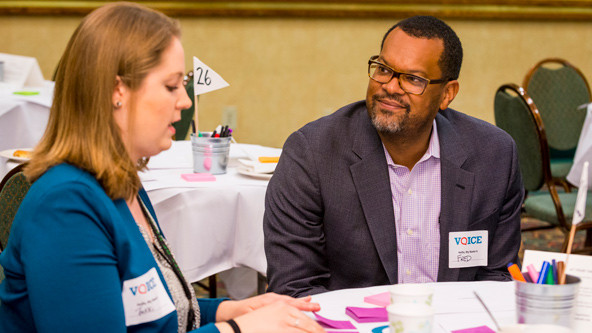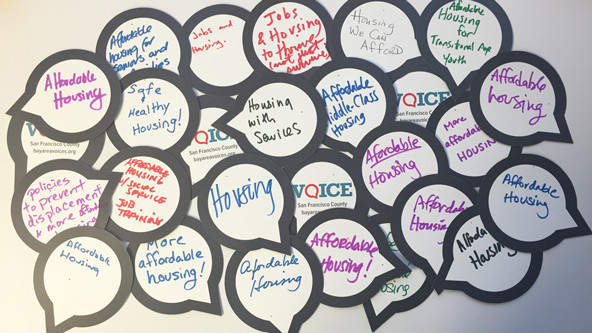For those of us who live in the San Francisco Bay Area and consider ourselves progressive, it is past time to come to terms with our inconvenient truth: We have a race problem. Arriving at this truth and examining how a community foundation could address it became an exercise in melding data on the issues with feedback from our community and experts on racial equity and economic inclusion.
While we live in the dark blue region of a blue state, we are not directly embroiled in the more visible battles around race, such as debates on whether confederate statues should sit in public spaces. But our perception of ourselves as progressive conflicts with the outcomes experienced by low-income people and persons of color when it comes to issues ranging from educational achievement and economic mobility to housing affordability, health, or involvement with the criminal justice system. Addressing the reality of racial discrimination has led The San Francisco Foundation to adopt an equity agenda to advance racial equity and economic inclusion at a regional scale.

For funders seeking to refresh their engagement strategies, we share the approaches we adopted to listen, consult, and use feedback to reshape our grantmaking strategy and the foundation’s role in addressing inequities facing Bay Area residents.
 The San Francisco Community Foundation CEO Fred Blackwell attends one of the community listening sessions. (Photo courtesy of The San Francisco Foundation)
The San Francisco Community Foundation CEO Fred Blackwell attends one of the community listening sessions. (Photo courtesy of The San Francisco Foundation)
Listening to the Community
Data can provide a starting place to get a clear picture of a community’s most defining challenges. In our case, we commissioned research to provide an equity profile of the Bay Area. We had data disaggregated by race, ethnicity, geography, economic status, and more, which brought greater understanding of the disparities facing Bay Area residents. Yet while the data and the human realities behind it were illuminating, they did not point us toward solutions.
 (Illustration courtesy of The San Francisco Foundation)
(Illustration courtesy of The San Francisco Foundation)
For that, we opened up a dialog with our community partners and listened intently to the people most impacted by the inequities in our region. Listening was critical to reimagining how we delivered on our mission.
In 2014 we launched a listening initiative called VOICE. VOICE became a series of community focus groups with residents, community leaders, and public officials in the five Bay Area counties the foundation serves. We engaged people in conversation. We asked them questions. And, most important, we listened. What we heard ultimately helped to shape our strategy and an agenda to advance racial equity and economic inclusion for the Bay Area—and it helped us to execute on it.
Consulting Local Experts
Because we serve five Bay Area counties, we need to understand the challenges facing specific communities. In addition to VOICE, we held consultative sessions where we brought in place-based experts including, policymakers and nonprofit leaders to discuss the issues facing the Bay Area and our role in addressing inequities. The consultative sessions were equally important in assessing our work and giving us feedback on how we were positioned to respond to future challenges. As we got deeper into the process, we focused conversations with community leaders in the Bay Area where the issues of equity were most acute. We asked them: “How did the disparities become so acute in your community?” and “How can we work together on a solution?” Their responses were essential in helping focus our work. Those conversations led us to concepts of People, Place, and Power as important organizing pathways for how we would address equity in the region.
 Focus groups with residents, community leaders, and public officials helped shape the San Francisco Foundation's strategy and an agenda to advance racial equity and economic inclusion. (Photo courtesy of the San Francisco Foundation)
Focus groups with residents, community leaders, and public officials helped shape the San Francisco Foundation's strategy and an agenda to advance racial equity and economic inclusion. (Photo courtesy of the San Francisco Foundation)
Converting Feedback to Strategy
To convert all this feedback into an effective strategy, we had to disaggregate the feedback—this time into ideas for what we should fund and how we should structure that funding.
From the consultative sessions, we heard that we were one of a few foundations that nonprofits could rely on to support organizing, movement building activities, and advocacy. In response, we made that an important pillar of our Power pathway to nurture equity movements. We heard that arts and culture was an important part of creating a strong sense of place (this led to our Place pathway) and important emotional touchpoints for community organizing efforts (our Power pathway). So, we infused our arts work into those two bodies of work accordingly. We also heard that housing affordability and displacement issues were fundamentally changing the character of communities and making it hard for people of color to maintain their stronghold in the Bay Area. So, within our equity agenda we have a strong focus on housing that cuts across the People, Place, and Power pathways.
Our grantees also felt that changing the way we funded them could help achieve greater impact. They said our grants were too small, too restricted, and distributed over too short a time frame. Based on their feedback, we now make larger grants over multiple years and skew toward providing operating rather than programmatic support.
Two and a half years after announcing the equity agenda, it is ingrained throughout our work. And now we are overdue for another round of community listening sessions. When we launch them, we expect to garner even more ideas for creating impact than in the first round. And we expect these new learnings will lead us to correct course, to deepen our commitment where we hear of positive results, and to find new ways to advance our equity work where it’s most needed based on feedback from our community.
This article is part of a series that was produced for Stanford Social Innovation Review by Milway Media with the support of the William and Flora Hewlett Foundation.
Support SSIR’s coverage of cross-sector solutions to global challenges.
Help us further the reach of innovative ideas. Donate today.
Read more stories by Fred Blackwell.

